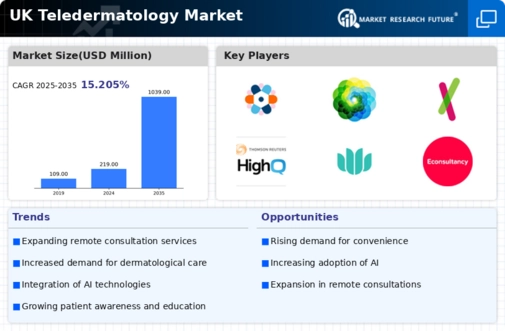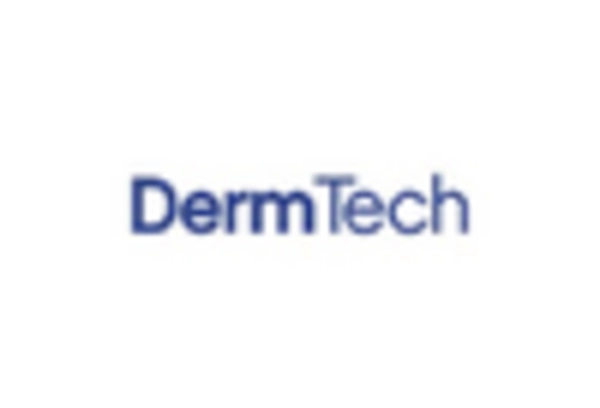Rising Incidence of Skin Disorders
The teledermatology market is significantly influenced by the increasing incidence of skin disorders in the UK. Conditions such as eczema, psoriasis, and skin cancer are becoming more prevalent, prompting a greater need for dermatological services. According to recent health statistics, approximately 1 in 5 individuals in the UK will experience a skin condition at some point in their lives. This rising demand for dermatological care is pushing healthcare providers to adopt teledermatology solutions, which offer timely access to specialists. The convenience of remote consultations is particularly appealing in rural areas, where access to dermatologists may be limited. As the incidence of skin disorders continues to rise, the teledermatology market is expected to expand, providing essential services to a growing patient population.
Cost-Effectiveness of Teledermatology
The teledermatology market is increasingly recognized for its cost-effectiveness, which is a crucial driver for its adoption in the UK. Teledermatology services can reduce the need for in-person consultations, thereby lowering overall healthcare costs for both patients and providers. Studies indicate that teledermatology can save up to £100 per consultation compared to traditional methods, making it an attractive option for budget-conscious patients. Additionally, healthcare systems benefit from reduced hospital visits and shorter waiting times, which can enhance patient satisfaction. As the UK healthcare system seeks to optimize resources, the cost-effectiveness of teledermatology is likely to play a pivotal role in its growth, encouraging more healthcare providers to integrate these services into their offerings.
Increased Focus on Preventive Healthcare
The teledermatology market is benefiting from a growing emphasis on preventive healthcare. As awareness of skin conditions rises, patients are increasingly seeking early diagnosis and treatment options. This trend is particularly evident in the UK, where the National Health Service (NHS) promotes regular skin checks to prevent serious conditions such as melanoma. The convenience of teledermatology services allows patients to consult dermatologists without the need for in-person visits, thus encouraging more individuals to seek care. It is estimated that around 30% of patients in the UK prefer teledermatology for its accessibility and efficiency. This shift towards preventive care is likely to drive the growth of the teledermatology market, as more patients recognize the benefits of early intervention.
Technological Advancements in Dermatology
The teledermatology market is experiencing a surge due to rapid technological advancements. Innovations in imaging technology, such as high-resolution cameras and artificial intelligence algorithms, enhance diagnostic accuracy and patient engagement. The integration of mobile applications allows patients to easily upload images of skin conditions, facilitating remote consultations. In the UK, the market is projected to grow at a CAGR of approximately 15% over the next five years, driven by these technological improvements. Furthermore, the development of secure data transmission methods ensures patient confidentiality, which is crucial for the acceptance of teledermatology services. As technology continues to evolve, it is likely that the teledermatology market will expand, offering more sophisticated solutions for both patients and healthcare providers.
Growing Acceptance of Telehealth Solutions
The teledermatology market is witnessing a growing acceptance of telehealth solutions among both patients and healthcare providers. This shift is largely attributed to the increasing familiarity with digital health technologies and the convenience they offer. In the UK, surveys indicate that over 70% of patients are open to using telehealth services for dermatological consultations. This acceptance is further bolstered by the positive experiences of patients who have utilized teledermatology, reporting high levels of satisfaction with the quality of care received. As more healthcare professionals recognize the benefits of teledermatology, including improved patient access and reduced workload, the market is likely to see continued growth. The increasing acceptance of telehealth solutions is a key driver for the expansion of the teledermatology market.

















Leave a Comment